Varroa Mites Reproduce in Capped Brood Cells
Varroa Mites Reproduce in Capped Brood Cells by USDA
Reproduction by varroa mites coincides with the pupal stages of honey bee metamorphosis, which occur within a capped brood cell. We focus on the relationship between varroa mites and worker bees. Female varroa mites live on adult bees when not reproducing. Adult male mites cannot live outside the capped brood cell. The following pictorial will show how the growth of mite populations depends on the availability of honey bee brood.
|
Metamorphosis of Honey Bees
Development of honey bees is similar to the metamorphosis in butterflies. The stages of development and the duration of each stage for a worker bee are given by the following sequence:
egg (3 days) –> larva & prepupa (8 days) –> pupa (9 days) –> adult
total development time = 19.5 – 20 days
The egg and early larval stages live in uncapped brood cells. The last two days of the larval stage, the pupal stage, and the first half-day of the adult stage occur beneath capped brood cells. The following description of honey-bee metamorphosis contains references of time in days. The reference point is the moment the egg was laid by the queen bee.
|
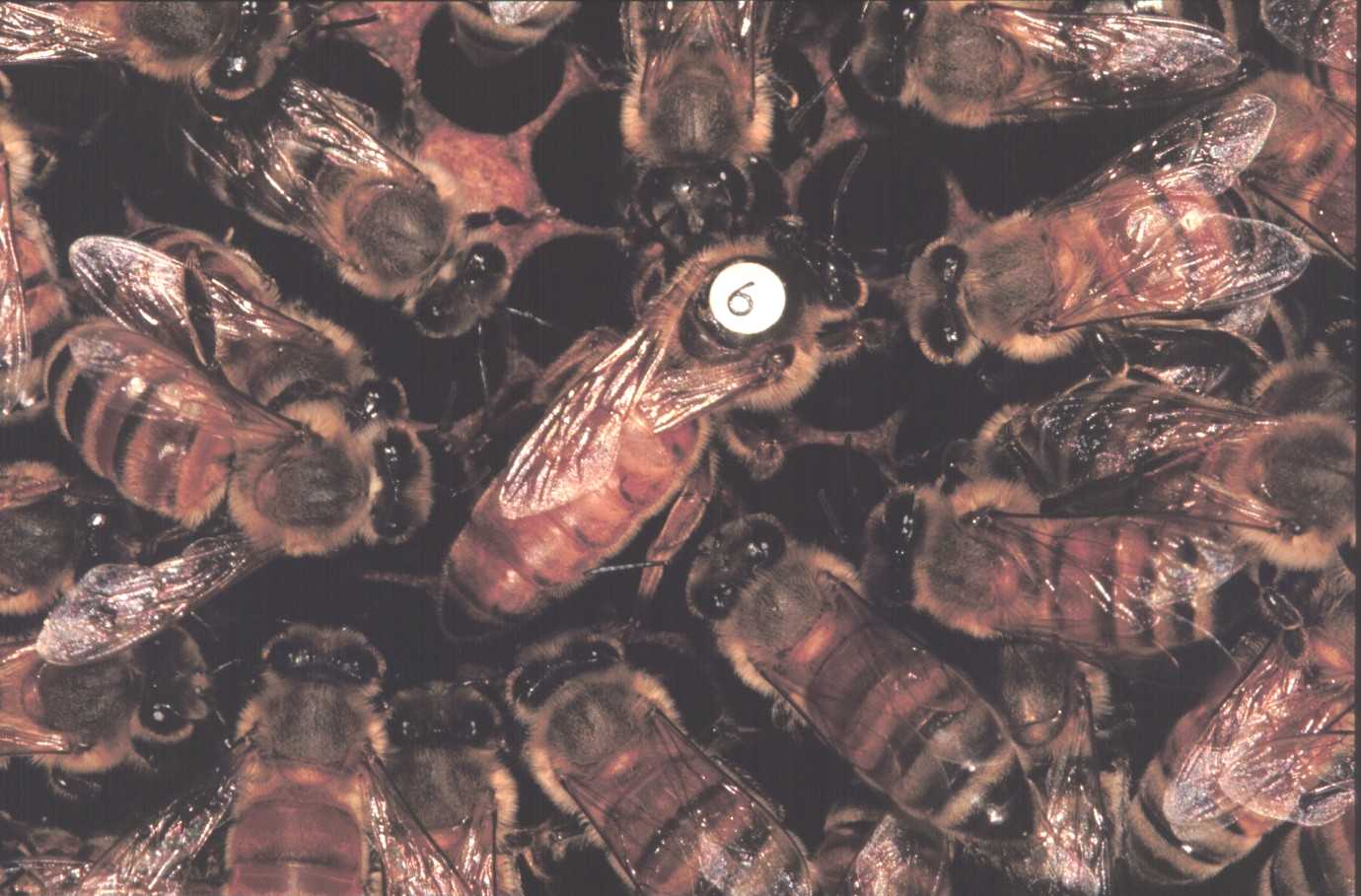
A queen bee and her court of attendant worker bees.
Step 1: Queen bee lays the egg.
Only one queen lives within a colony of honey bees. She lays up to 2,500 eggs per day. The worker bees care for the queen and the young brood.
|
|
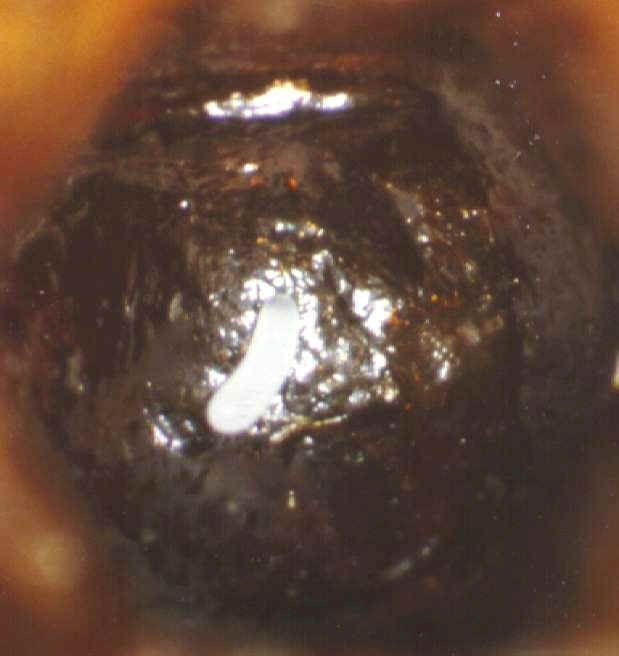
Worker egg in bottom of brood cell (ca. 120x magnification).
A single egg is laid in a brood cell.
The life of a worker honey bee begins when the queen lays a fertilized egg onto the base of a worker-sized brood cell.
|
|
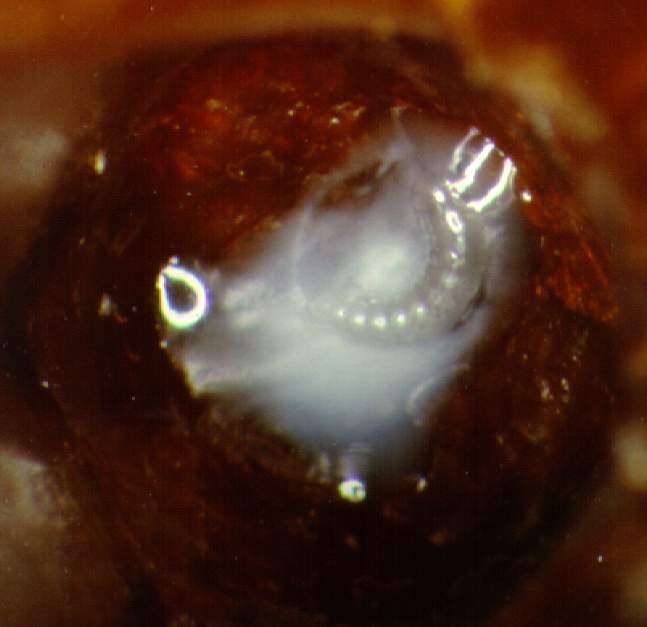
A young worker larva lying in a pool of brood food.
Step 2: A larva hatches from egg after three days.
Nurse bees feed brood food to the larva within minutes of hatching. Glands in the head of nurse bees secrete the liquid diet. The nurse bees continue to feed the larva until the cell is capped.
|
|
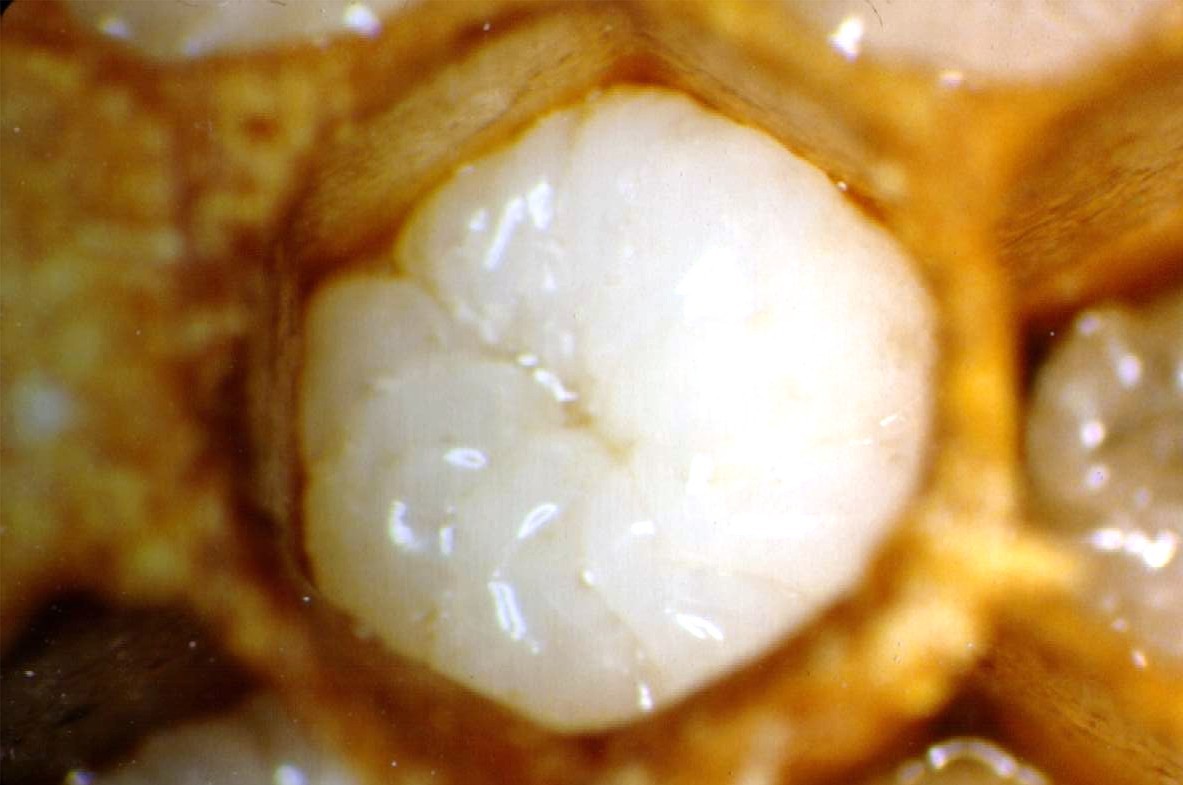
An old larva as seen on the 7-8th day of development, just before the cell is capped by adult bees.
Step 3: Larva grows large on steady diet of brood food.
The worker larva sheds its skin (or molts) as it grows. The first four molts occur every 24 hours after the larva hatches. The fourth larval molt occurs by the end of day 7 when the larva occupies the entire floor of its brood cell. At 8 days the larva sends out chemicals that signal attendant worker bees to cap the brood cell. The final larval molt occurs on the 11-12th day (see below).
|
|
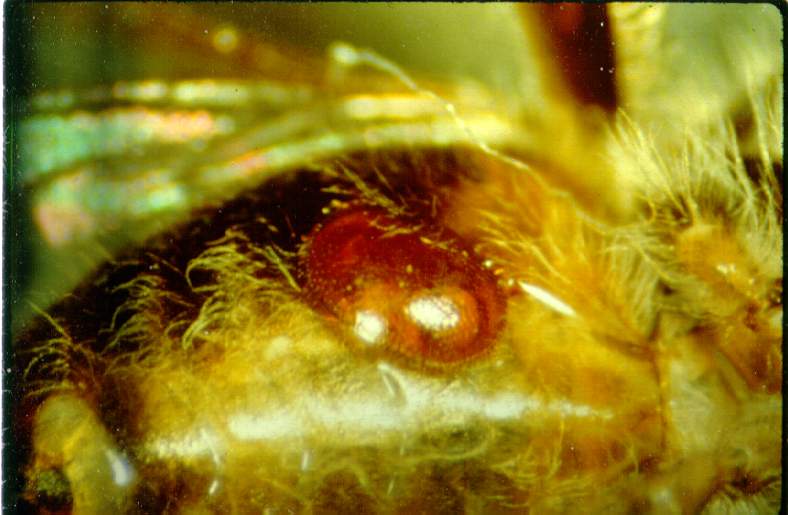
Adult mite on abdomen of an adult worker bee (photo courtesy of Dr. Keith Delaplane; University of Georgia).
Varroa mites live on adult bees when not laying eggs.
Adult varroa mites live on adult bees when not reproducing. The average time spent on adult bees between reproductive cycles varies from a few days to more than a month. About 7 days is typical.
A mite begins her reproductive cycle by invading a worker cell about 0-18 hours prior to it being capped. A single mite may experience 3-8 reproductive cycles in her entire life, but the average number of cycles is 3.
|
|
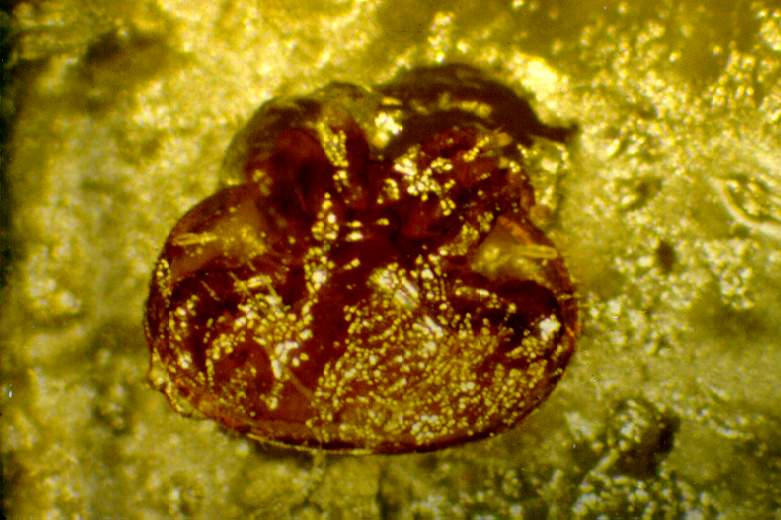
Immobile varroa mite in brood food. The third and fourth pairs of legs have been spread to show the two peritremes.
Step 4: A mite invades the brood cell before it is capped.
A varroa mite invades a brood cell by running from the belly-side of a nurse bee into the cell opening. She runs down the cell wall and into the brood food beneath the bee larva. The mite becomes immobile while immersed in the brood food (she looks dead while in the jelly).
She breathes air with specialized tubes called peritremes. The peritremes are the thin, pale-colored tubes between the last two pairs of legs.
|
|
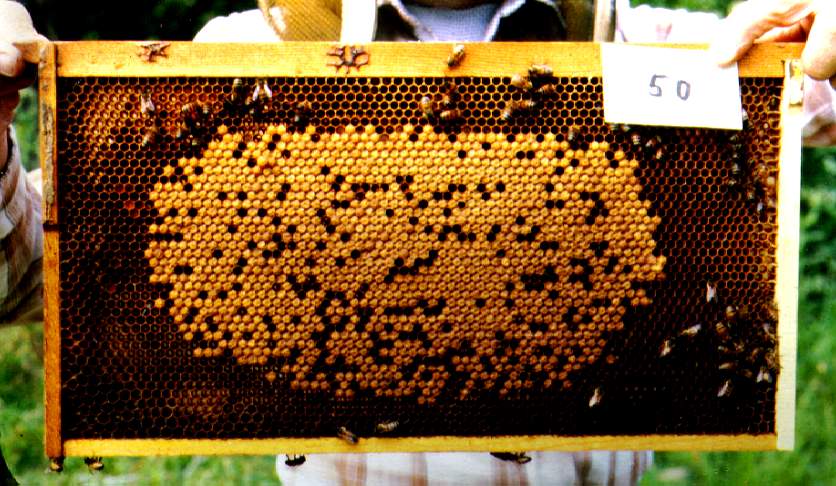
A brood comb showing capped worker cells.
Varroa mites remain immobile while immersed in brood food.
A varroa mite remains motionless until all of the brood food is eaten by the larva during her first 24-30 hours in the cell. Most mites wake up and begin feeding on the blood of the bee larva by the end of the 9th day.
|

The bottom half of the cocoon that lines a worker brood cell. The top half was torn during removal from the cell. The dark spots are dried feces.
Step 5: Bee larva spins a cocoon.
The bee larva will defecate soon after eating all of the brood food. Then she spins a cocoon using silk that is produced by glands within her mouthparts. The cocoon completely surrounds the larva when it is finished. The cocoon usually provides a barrier between the larva and the feces, but sometimes larvae will defecate after the cocoon is complete. Metamorphosis is completed within the protective cocoon.
|
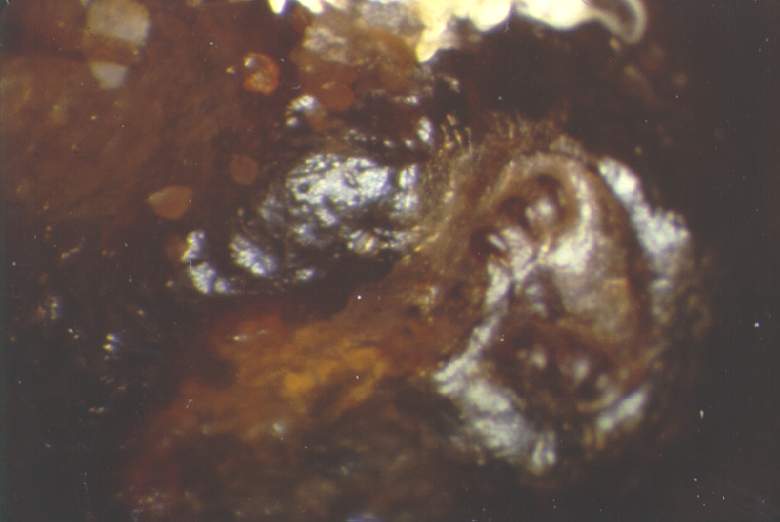
A varroa mite that has been trapped between the cocoon and the cell wall (as seen from above after removing the bee larva).
Sometimes mites get trapped!
If a varroa mite does not wake up before the bee larva spins the cocoon, the cocoon will be spun over the mite. Then the cocoon separates the mite from the larva. We call this condition of the mite ‚entrapped by the cocoon‘. Usually, very few varroa mites become entrapped by the cocoon; however, we have produced resistant bees that have high levels (> 25%) of entrapped mites . An entrapped mite will die because it cannot feed.
|
|
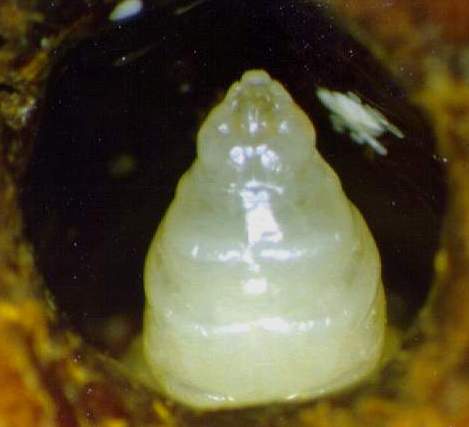
A worker prepupa. Notice the pile of mite feces located on the cell wall (to the right of prepupa).
Step 6: The bee larva becomes a prepupa.
The bee larva changes into a prepupa within hours of finishing the cocoon. The prepupa lies motionless in the brood cell as it prepares to shed the last larval skin. This stage lasts for nearly two days spanning the 10-11th days of bee development.
Most varroa mites begin to suck the blood of the host bee during the late larval to early prepupal stage. The mite pierces the body of the host with her mouthparts and sucks the blood like a tick might suck the blood from a dog. A varroa mite and her family usually feed from one wound.
The feeding site (or wound) is usually located in the lower 1/3 of the brood cell. Varroa mites tend to repeatedly defecate on the cell wall near the feeding site. The pile of mite feces is white.
|
|
Metamorphic Development of Varroa Mites
The development of varroa mites is similar to the gradual metamorphosis exemplified by other mites and insects like grasshoppers. The different stages of development and the duration of each stage are given in the following sequences:
Male Varroa Mites
egg (30 hr) –> protonymph (52 hr) –> deutonymph (72 hr) –> adult
total development time = 6.5 days
Female Varroa Mites
egg (20-24 hr) –> protonymph (30 hr) –> deutonymph (75-80 hr) –> adult
total development time = 5 – 5.5 days
All stages of a varroa mite development occur within the capped brood cell. A typical female mite will lay one male egg and 4 female eggs during her reproductive cycle in worker brood. However, only the son and the 1 or 2 oldest daughters will reach adulthood before the honey bee emerges from the brood cell (see below).
|
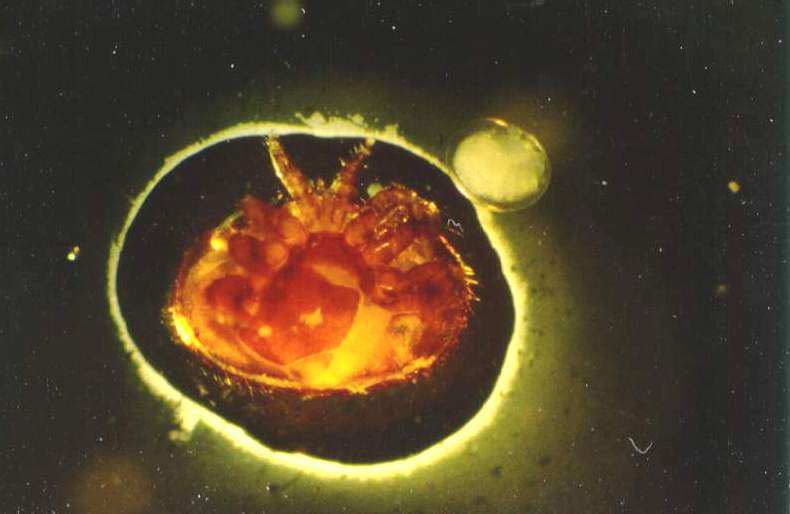
The first egg from a varroa mite (next to the right side of the mite). It was removed from the mite under a microscope. The white ring around the mite is light reflecting from the glue that was used to anchor it for dissection.
Step 7: The body of the mite swells as the first egg develops.
The steady diet of blood from the prepupa provides the varroa mite the nutrition needed to make eggs. A mite’s body swells as an egg matures within her ovary.
|
|

The skin sticks to the floor of the brood cell [ca. 80x magnification].
Step 8: The prepupa sheds the last larval skin.
The prepupa becomes a pupa at the end of the 11th day after it has shed the old larval skin. This molt is the 5th and final larval molt of the honey bee.
|

A varroa mite (center) with her first egg (upper left). The yellowish material below the mite is the shed larval skin from the prepupa, and the white material in the lower right of the cell is the mite feces.
Step 9: The mite lays her first egg.
The first egg is laid on the wall of the brood cell before the end of the bee’s prepupal stage. Otherwise, the egg is laid in the first pupal stage (below). The first egg is almost always a male. The female mite will lay an egg every 30 hours over the next few days (usually not more than 5 eggs are laid in a worker brood cell).
|
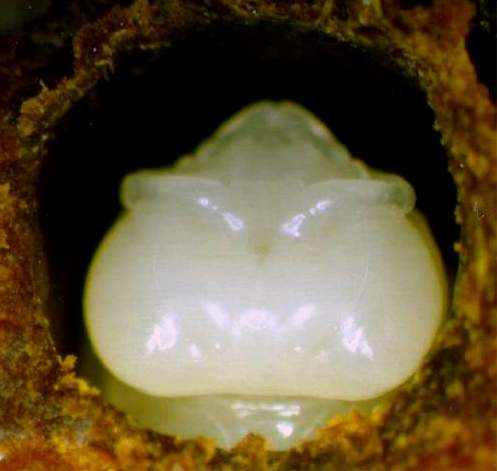
The first pupal stage of the worker bee begins on the 11-12th day. Neither the body nor the eyes of the pupa are pigmented.
Step 10: The prepupa becomes a pupa.
The head of the prepupa enlarges by the end of the 11th day, marking the beginning of the pupal stage of bee development. The tissues of the pupa will continue changing to form the adult insect. The most noticeable changes are an increase in pigmentation of the eyes and body as the pupa ages.
|

The eyes of the bee pupa appear pale pink but its body remains white on the 13th day.
Step 11: The eyes of the pupa begin pigmentation.
The eyes become pigmented before other parts of the bee. There is no movement of legs, antennae or mouthparts during the early pupal stages.
|
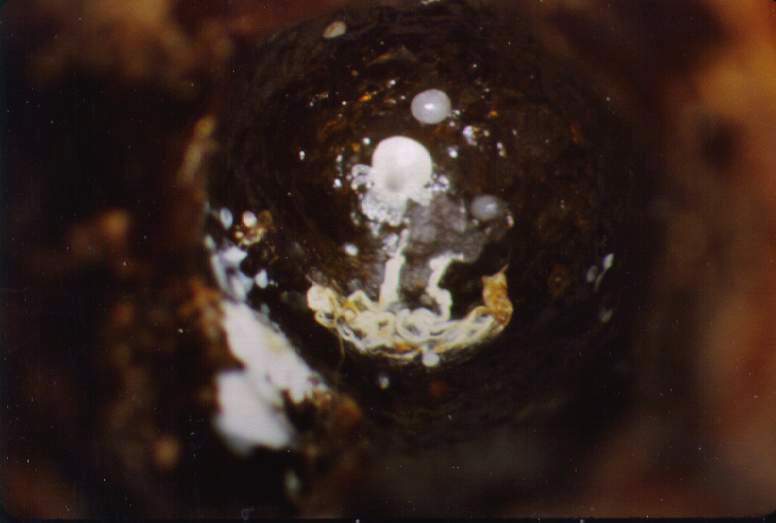
The male protonymph as seen during day 12-13 of the honey bee’s pupal development. This cell also contains two additional mite eggs (one above and one to the right of the male)
Varroa mite family grows.
The adult mite continues to lay eggs. At this point, a typical family of varroa mites consists of the mother mite, a male protonymph, a female protonymph and another egg that will become a female mite.
|
|
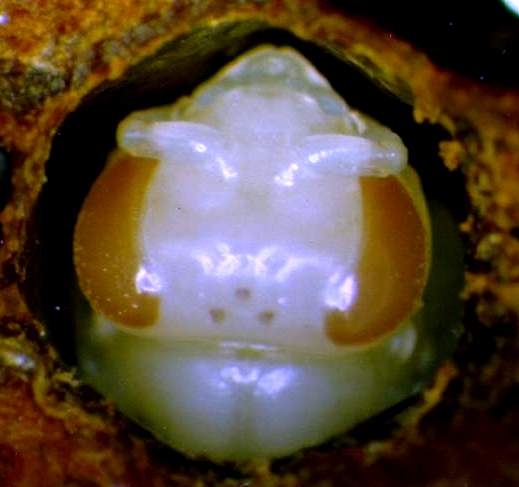
Pupa of worker bee on the 13-14th day of development.
Step 12: Eye pigments darken.
The compound eyes and the ocelli (the three small eyes at the center of the head) appear pink on the 14th day. The pupa still does not move its appendages.
In regards to the mite family, the male protonymph and the oldest female protonymph will molt to become deutonymphs during this stage of bee development. The second oldest daughter mite hatches from the egg to become a protonymph, and the 4th egg is laid by the mother mite.
|
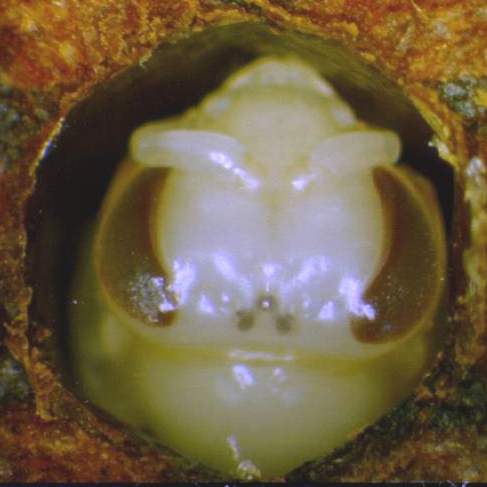
The purple-eyed bee pupa as seen on the 15th day of development.
Step 13: Eyes are purple on the 15th day.
The body is still white or slightly yellow, but some brown pigment appears in the antennae and mouthparts at this stage.
|
![A mite family as seen at the beginning of the 15th day of bee development. The four mite progeny are: (1) egg [below mother mite], (2) female deutonymph [lower left of mother mite], (3) male deutonymph [immediately above mother mite] and (4) a female protonymph [farthest above and to left of mother mite].](http://www.resistantbees.com/fotos/blog/varroa19.jpg)
A mite family as seen at the beginning of the 15th day of bee development. The four mite progeny are: (1) egg [below mother mite], (2) female deutonymph [lower left of mother mite], (3) male deutonymph [immediately above mother mite] and (4) a female protonymph [farthest above and to left of mother mite].
The core of the mite family is completed.
Although the mother mite can lay more eggs (and they sometimes do), none of those additional progeny will have time to mature into adult mites before the honey bee emerges from the brood cell. In fact, the egg (the 3rd daughter for this particular mother mite) in the picture to the left has only a 13% chance of reaching adulthood.
|
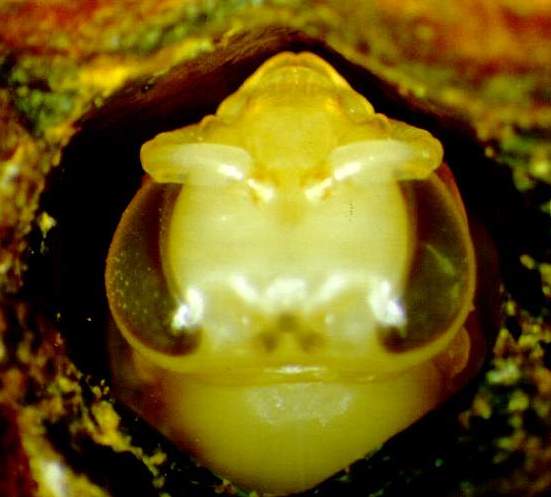
A tan-colored pupa as seen on the 16-17th days of metamorphosis.
Step 14: The bee’s body darkens.
The body of the bee has a yellowish tan appearance on the 16-17th day of development. The pigmentation of the antennae, mouthparts and legs increases. Some slight movements of the legs can be seen at this time.
|

The body of the pupa as seen on the 16-17th day. Notice that the joints on the legs are pigmented. The white spots on the pupa’s abdomen are mite feces.
|
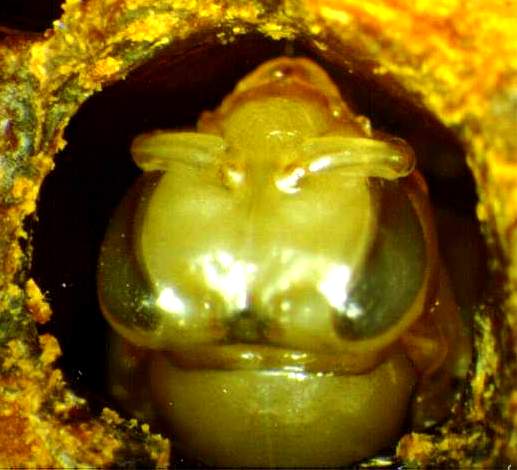
By the end of the 17th day, the pupa has a dark tan or gray appearance.
Step 15: Body becomes more pigmented.
As the pupa’s body darkens, movements of the legs and mouthparts are more frequent. The wing pads become gray-colored.
|
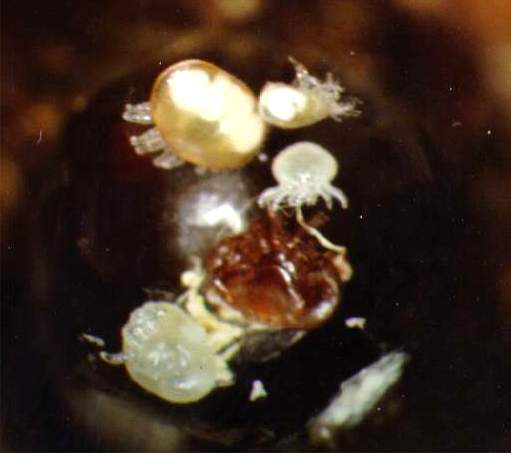
A mite family as seen on the 17-18th day of the bee’s development. The family consists of the mother mite, and her adult son and adult daughter (both located the farthest above the mother mite). The remaining two progeny are female deutonymphs.
Step 16: The oldest mite progeny reach adulthood.
The son and first daughter will reach adulthood during the 17-18th days of the bee’s metamorphosis. After molting from the deutonymph stage, the young adult mites are white. Their bodies begin to darken over the next few hours to days. Female mites will become as brown as their mothers, but adult males remain a light tan color.
The adult son and adult daughter mites will mate several times. The female mite stores 40-70 spermatozoa within her spermatheca, and she will use them later in life to fertilize eggs that she lays in a brood cell. Mating occurs near or on the pile of mite feces. Some scientists believe that the mite feces contains chemicals that attracts both sexes to the spot for feeding and mating. These mites do not have eyes and may depend on touch or smell to find each other.
|
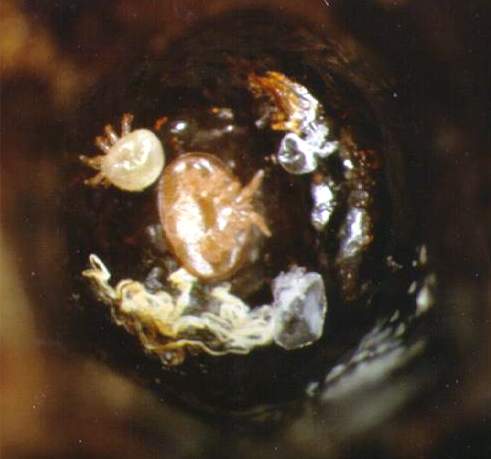
Adult male and female mites that had just recently molted from the deutonymph stage. Their shed skins are the transparent or whitish objects located to the right of the two mites (the male skin is smaller and located near the top of the cell, and the female skin is touching the honey bee’s old larval skin)
Varroa mites shed their skins twice during metamorphosis.
Varroa mites go through two molts as they mature. The first molt occurs when a protonymph becomes a deutonymph. The skin from this first molt is so small that it cannot be seen. The second molt occurs during the transition from deutonymph to adult. The skin from this molt can be readily seen in the brood cell.
|
|
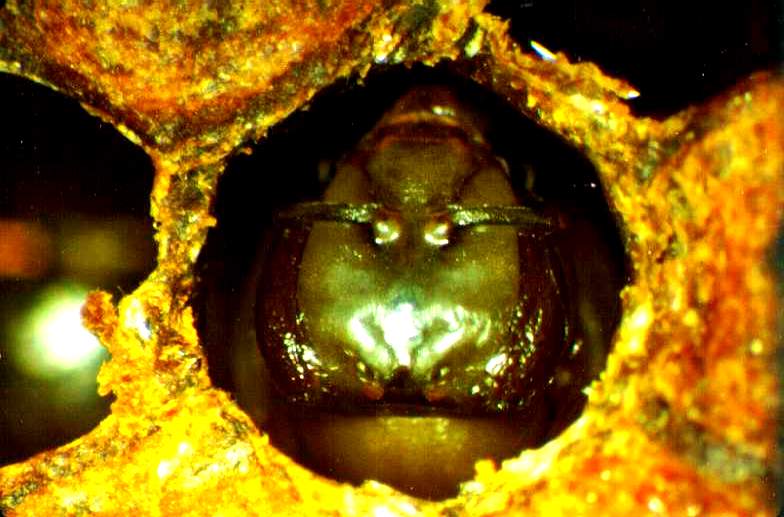
Bee pupa on the 18-19th day of development.
Step 17: Bee pupa prepares for final molt.
The body color of the pupa becomes a dark gray or black on the 18-19th day. Movements of the legs are more prevalent during this period. The wings expand, and hair grows on the body.
|
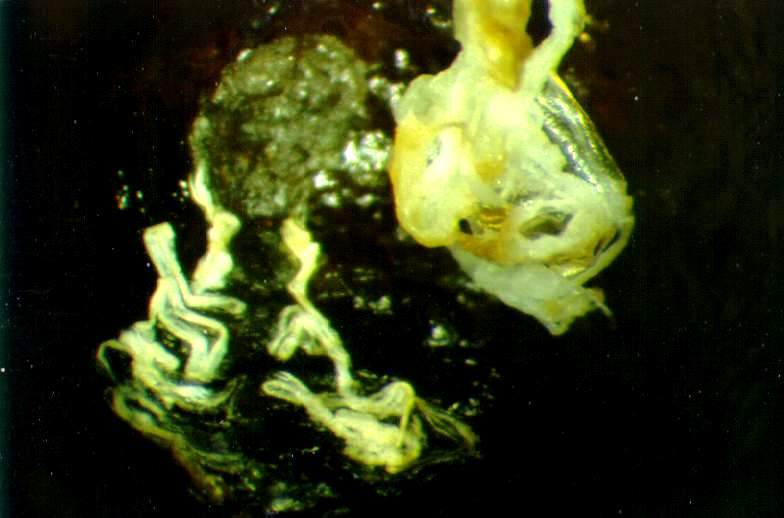
Close-up of the two skins that can be found in a brood cell after the adult bee leaves the cell. The skin to the lower left is the old larval skin that was shed in step 8 (above). The skin in the upper right is the pupal skin that was shed as the pupa became an adult bee.
Step 18: Pupa molts and becomes an adult bee.
The pupa-to-adult molt of the honey bee occurs by the end of the 19th day. Several hours after the wings expand, the adult bee sheds the pupal skin. Movements of the legs can be vigorous at this time, which can injure any soft-bodied mites that exist in the brood cell (the adult male or immature female mites).
|
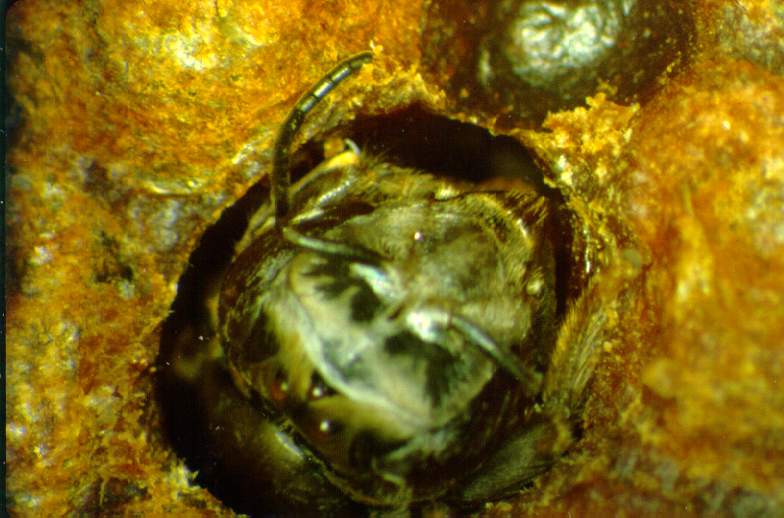
An adult worker bee chewing away the cell capping so that she can emerge from her brood cell.
Step 19: The adult bee chews away cell cap.
The pupa-to-adult molt occurs about 12-20 hours before the adult bee emerges from the cell. The young bee expands her wings and finishes hardening her exoskeleton during this period of time. Her body movements are frequent and strong; therefore, immature mites are not likely to survive. Even adult male mites are vulnerable.
|

An adult worker bee emerging from her brood cell on the 19-20th day. This bee has an adult mite riding on her thorax (it’s hard to see in the photo, but the reddish disc on the thorax is a varroa mite).
Step 20: Adult bee exits the cell.
The young adult bee leaves her brood cell about 20 days after the egg is laid. The adult female mites ride the bee as she exits. In most cases, the mother mite and only 1-2 mature daughters will leave the brood cell. An average of 1.4 – 1.5 daughters per mother mites is typical for a population of mites.
The male mite usually remains in the brood cell. He will be killed and removed by nest cleaning bees that prepare newly vacated brood cells to receive another egg from the queen bee.
|
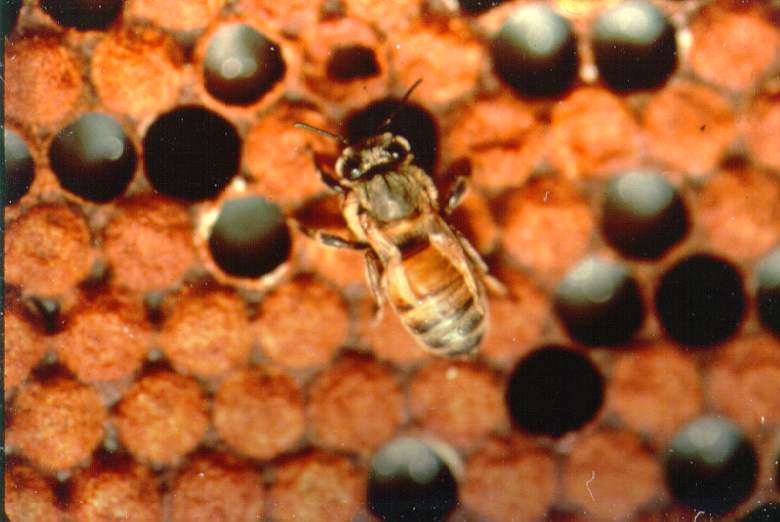
An adult worker bee with damaged wings as the result of developing within a brood cell infected by varroa mites (photo courtesy of Dr. Keith Delaplane; University of Georgia).
The feeding activities of varroa mites damage their host bees.
Often worker bees that have been parasitized by varroa mites are underweight and have deformed wings. Injuries from the feeding mites damage and weaken bees to the point that the wings do not expand properly. Varroa mites can also infect bees with dangerous viruses and bacteria.
|
Although varroa mites infect worker brood cells of our western honey bee, they prefer drone brood cells when available (early spring). Development of a drones is similar to that of a worker bees, but the overall development time for drones is 23-24 days. The capped period for drones is 14-15 days. The extra 2.5 days (relative to the capped period for worker bees) provides time for an additional 1-2 daughter mites to mature. A single mother mite can produce 3-5 mature daughters within a capped drone brood cell, but the average number of daughters per mite in drone cells is about 2-2.5. We do not allow drones to be raised in our experimental colonies when we are breeding for resistance to varroa. Our research has focused on breeding for resistance to varroa mites by observing mite reproduction in worker brood cells only.
P V
7518


















![A mite family as seen at the beginning of the 15th day of bee development. The four mite progeny are: (1) egg [below mother mite], (2) female deutonymph [lower left of mother mite], (3) male deutonymph [immediately above mother mite] and (4) a female protonymph [farthest above and to left of mother mite].](http://www.resistantbees.com/fotos/blog/varroa19.jpg)











